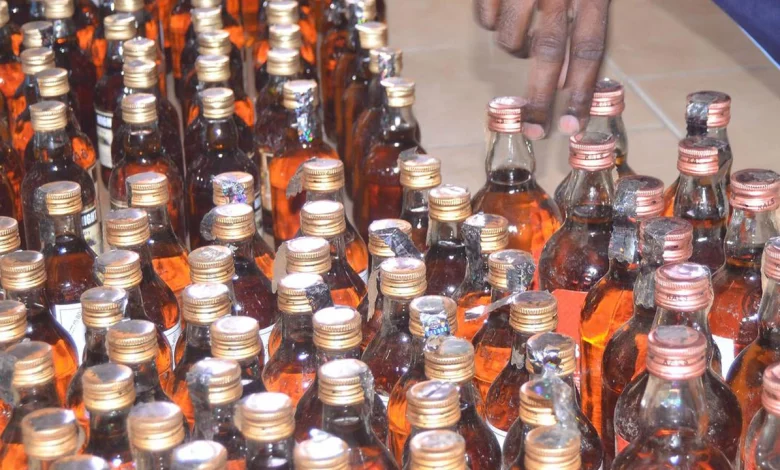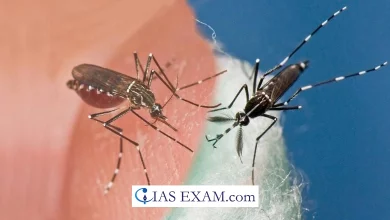
Context- In the districts of Tamil Nadu, spurious liquor had resulted in the deaths of 22 people.
What is the alcohol in liquor?
- The alcohol content of a drink is what separates it from other beverages, ranging from beer’s 5% alcohol by volume to wine’s 12% alcohol by volume to distilled spirits’ 40% alcohol by volume.
- The alcohol in question is almost always ethanol in beverages used for recreation. Technically, ethanol is a psychoactive substance that has typical intoxicating effects when taken in low doses because it lowers the level of neurotransmission in the body.
- According to the World Health Organization, there is no safe level of consumption. Long haul use prompts reliance, uplifts the gamble of certain malignant growths and coronary illness, and may ultimately cause death.
What is spurious liquor?
- The methanol-containing liquid mixture also defines spurious liquor.
- Most of the time, this kind of liquor is made at home, like arrack, and methanol was added to boost its intoxicating effects or increase its bulk volume.
- The maximum amount of methanol that can be found in various alcoholic beverages is set by the Food Safety and Standards (Alcoholic Beverages) Regulations of 2018. These qualities length a wide reach, including “missing” in coconut fenny, 50 grams for every 100 liters in country alcohol, and 300 grams for each 100 liters in pot-refined spirits.
What is CH3OH-methanol?
- The most well-known method for creating methanol is to join carbon monoxide and hydrogen within the sight of copper and zinc oxides as impetuses at 50-100 atm of strain and 250°C.
- Methanol has a few modern applications, including as a forerunner to acidic corrosive, formaldehyde, and fragrant hydrocarbons. Additionally, it is utilized as antifreeze and a solvent.
How does spurious liquor kill?
- Methanol is what gives fake liquor its speed.
- According to a study conducted in 2006, eating certain fruits results in the human body accumulating tiny amounts of methanol (4.5 ppm in the breath of healthy individuals). However, it can be fatal even for adults to consume more than 0.1 milliliters of pure methanol per kilogram of body weight.
- Methanol is broken down in the liver by ADH enzymes into formaldehyde (H-CHO) after being ingested. Formaldehyde is then transformed into formic acid (HCOOH) by ALDH enzymes.
- Metabolic acidosis is a terrible condition caused by the buildup of formic acid over time. Acidemia, in which the blood’s pH falls below the normal value of 7.35 and becomes increasingly acidic, can result from acidosis.
- Methanol consumption also causes methanol-induced optic neuropathy, a serious condition that can cause permanent or irreversible blindness or vision loss.
- Poisoning with methanol can also result in cerebral edema, bleeding, and death.
How can such poisoning be treated?
- The body takes some time to completely eliminate methanol after it is ingested. After 48 hours, as much as 33% are still missing, according to one estimate.
- There are two quick methods for treating methanol harming.
- One is to regulate ethanol: Ethanol contends very well with methanol for the ADH compounds. Thus, the methanol is held back from being processed to formaldehyde.
- The administration of an antidote known as fomepizole, which works in a similar way by slowing the action of the ADH enzymes, is another option. It causes the body to produce formaldehyde at a rate that the body can quickly excrete, thereby preventing the more harmful effects from taking effect.
- In order to lessen damage to the kidneys and retina and remove methanol and formic acid salts from the blood, healthcare providers may also order the patient to undergo dialysis.
- If the individual consumed both ethanol and methanol, the damage may not become apparent for several days, delaying treatment even further and increasing mortality.
Alcohol prohibition in India
- It is currently in effect in five states—Bihar, Gujarat, Lakshadweep, Nagaland, and Mizoram—along with a few others that only prohibit alcohol in part.
- State subject: Albeit the preclusion of liquor use is empowered in the constitution of India (Article 47, DPSP), liquor strategy is a state subject.
- States are having full control of liquor related regulation, extract rates and the creation, circulation and offer of liquor.
- Arguments in favor of a prohibition on alcohol consumption: Even if liquor is not sold, a strong economy can still exist. Black money that has been hidden abroad can be brought back to the country and corruption can be contained within the government if the government ensures that there are no tax evasions.
- DPSP: The state government is obligated to protect public health. The directive principles of state policy make it abundantly clear that improving nutrition, living standards, and public health is the state’s responsibility.
- Negative to Health: Everyone knows that drinking alcohol is bad for your health, and no doctor has ever said that drinking alcohol will make your health better. It hinders the body’s overall function in addition to causing damage to the liver.
- Affects the poor: A significant portion of the household income that should have been used to improve a person’s standard of living is spent on alcohol in low-income households where a person has an alcohol addiction.
- Social Issues: Alcohol is likewise the purpose for propagating abusive behavior at home, hampering of family bonds, couples getting separated and youngsters getting disregarded.
- Crime and addiction on the rise: Young people are becoming dependent on alcohol due to its easy availability. It would appear that a significant number of crimes are committed while under the influence of alcohol.
- Crime percentage: The crime rate will also decrease if the government prohibits liquor.
Arguments against Liquor ban
- Revenue for the government: The government argues that the sale of alcoholic beverages brings in a substantial amount of excise duty revenue, which it needs to grow the economy.
- Legal Perspective: A major issue would be a rise in crime as a result of withdrawal symptoms and the inability to locate and consume alcohol.
- Violent crime is on the rise: This is telling because if someone wants to drink alcohol while it is illegal, they will have to use illegal means. This is the reason alcohol prohibition is based on fear.
- The Right to liquor: Articles 21 and 19(1)(g) of the Indian Constitution provide the majority of the evidence in support of the claim that the Fundamental Rights guaranteed by the Constitution include the right to consume and trade alcoholic beverages.
Way Forward
- Not a fundamental right: No Indian citizen has the fundamental right to consume or trade liquor at this time. Particular state legislatures have an imposing business model over the alcohol market in India.
- Awareness: Specialists keep on upholding mindfulness and not forbiddance to be the best approach particularly in states where the law as of now precludes its utilization.
Inelastic way of behaving: Specialists keep on contending that liquor utilization is inelastic, and this is valid for states that don’t have a restriction on alcohol but see a colossal spike in passings because of false alcohol utilization.





.png)



